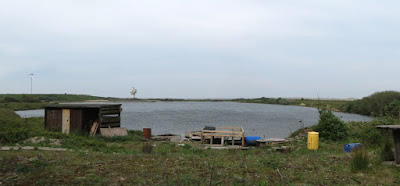 |
| Lagoons, Seaforth Nature Reserve L Bmson |
It's been many years since our group
visited the Seaforth nature reserve. Covering an area of 30ha
the reserve is situated within the north end of the Bootle docks system, at the mouth
of the Mersey. Comprising of two lagoons, one freshwater and
the other saltwater, surrounded by land formed by tipped infill now rabbit-grazed grassland,
and a small reed bed. Three hides are located by the freshwater lagoon.
A magnet for many species the reserve is a major roosting site
for waders and seabirds and ducks in winter; and nationally important for
spring passage Little Gulls. Wader roosts form 2-3 hours before high
tide, so we coincided or trip with the tides approach.
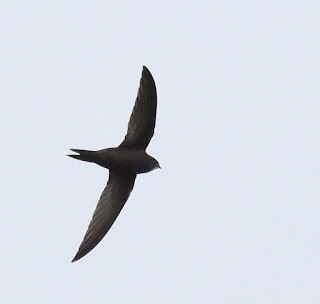 |
| Swift J Binks |
Arriving at the car park at Crosby marine lake (our meet up point) our
first sighting was a swift flying in over the lake, a welcome harbinger of
spring, newly arrived from its long migration. This was the first of our
migrants for the day and a very good omen it turned out to be.
The reserve itself
is a tadge difficult to locate, nestled in the dock complex and its maze of
units. Entrance to the reserve is by yearly permit £20 from Peel ports, if you have a permit you just arrive at the
docks, show your pass at the gate and go into the reserve. As this reserve is
leased and maintained by the Lancashire wildlife trust you should really be a
member of the trust (Join your local Wildlife Trust |
The Wildlife Trust for Lancashire, Manchester and North Merseyside)
and you may be asked to present your membership card when applying for the permit. Reserve
manager Fiona Whitfield 0151 9203769 seaforth@lancswt.org.uk
The first thing you notice as you drive through the complex is it’s a
dump! Industrial waste littered about, fortunately the reserve is better looked
after. The second thing you should notice as you enter the reserve is the
recently completed tern rafts by the trust offices, ready to be placed on the
lagoons for the returning common terns. The reserve has a breeding colony of
between 150-180 pairs of common terns and is one of the largest in the north of
England.
What a racket, we are greeted by a cacophony of calling gulls, intermingled with wader peeps and duck whistles and
babbles. What a fabulous place this is, sensory heaven.
We situated ourselves in the main hide, and by the wooden screens either
side. Our group was comprised of new birders and experienced birding stalwarts,
it wasn't long before bird species seen were being reeled off, complete with informative
identifying factors and other bird insights.
 |
| Oystercatchers, geese and gulls on grassy banks N Prendergast |
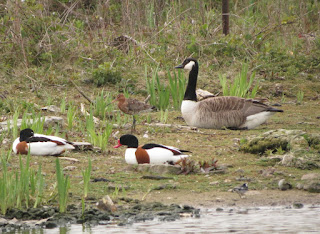 |
| Shelduck, godwit,canada goose,wagtail L Bimson |
On the lagoons we found ducks such as tufted, teal, goldeneye,
shelduck and mallard. On the grassy banks, two flighty, twittering linnets
foraged for small seeds. Large numbers of oystercatchers huddled and gulls
squabbled - black-headed, common,
herring, lesser and great black-backed. On
the shoreline a large group of
cormorants, which roost on the reserve daily, sun bathed, whilst a mute swan snoozed the morning away. Other guests, Canadian geese, lapwings,
redshank, godwits and a flamboyant ruff re-fueled or just took time out.
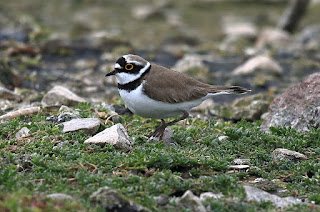 |
| Little ringed plover N Prendergast |
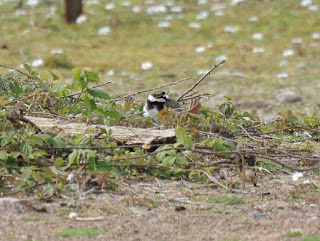 |
| Little ringed plover nest N Prendergast |
 |
| Knot and turnstone buddies L Bimson |
To the left of the hide on a narrow spit, we were delighted to find a diminutive
pair of little ringed plovers raking through the shingle. Turned out these
little clockwork dynamos had a nest a little further back on the shore. Wonder
what their chances are with all those predatory gulls about...mmh.
Moving to
the right of the hide another spit had a knot hanging out with a turnstone, or
so it seemed, as they stayed close for all the time we were there. They were
visited briefly by a common sandpiper and a white wagtail.
 |
| White wagtail N Prendergast |
The arrival of two whimbrel landing on the causeway spit, created a stir
and a discussion ensued on the differences between them and their larger cousin’s
curlew. (Excellent BTO video - BTO Bird ID - Curlew and Whimbrel ) Easily spooked
they didn't stay long, calling as the fled, a loud, rolling twitter. (XC301139 Whimbrel
(Numenius phaeopus) ) Wonderful.
 |
| Whimbrel N Prendergast |
Another call of note alerted us to
another surprise rare visitor to the reserve, a spotted redshank (http://www.xeno-canto.org/141507)
 |
| Black and bar tailed godwits L Bimson |
Several black tailed godwits were
already on the reserve on our arrival, another chance for an id lesson came
when 3 bar tailed godwits arrived, smaller with their upturned bill, splendid
in their stunning summer plumage (https://www.youtube.com/watch?v=ecJSoImIT2Y)
A little flock of wheeling dunlin came
in as with the tide, making 'shapes' as they circled the lagoon before landing
on the shoreline, their summer plumage little black bellies obvious.
Perhaps not one we expect to see here
was a raven, spotted high flying over the northern end of the
reserve.
Without a shadow of a doubt the terns that dropped into the reserve
during our visit made our day. It appears we were fortunate that on the day of
our visit the wind direction had changed to a south easterly and this
meteorological shift brought in a large fall of terns to our shores.
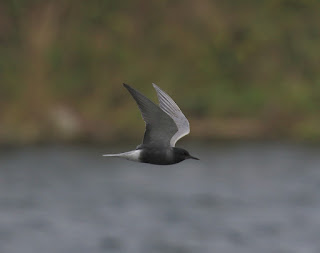 |
| Black tern N Prendergast |
When the first black tern turned up at 11.10am a commotion erupted, twenty
one birders dashing out the hide for a better view. Little did we know that by
the end of the day an astonishing twenty four will have arrived, taking a
break from their migration from Africa to their European breeding grounds such
as Finland. What fantastic birds these little terns are, with their distinctive black
head, swooping over the lagoons, dipping the surface for insects.
 |
| Terns in flight J Binks |
Seventeen sandwich terns gracefully winged in along with the Common terns,
some alighted on the shore and gave us yet another id lesson, larger with their
distinctive black head crest
 |
| Sandwich and common terns J Binks |
(https://www.rspb.org.uk/birds-and-wildlife/bird-and-wildlife-guides/browse-bird-families/terns.aspx
Last but not least worthy of a mention was the little gull, a popular
spring migrant to the reserve. This feisty endearing gull thoroughly
entertained us with his antics; little but full of character, hyper-active,
tern imitator and not afraid to take on bigger birds, at one point our bird
appeared to be having a flying face off with an oystercatcher!
 |
| Little gull N Prendergast |
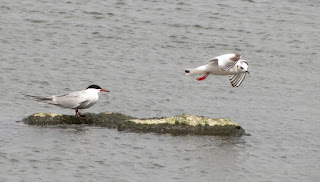 |
| Little Gull and Common Tern L Bimson |
Bird list
Swift, house martin, sand martin, swallow,
starling, magpie, wheatear, linnet, reed bunting, house sparrow, yellow wagtail,
pied wagtail, white wagtail, cormorant, little ringed plover, mute swan, Canada
goose , greylag goose, heron, whimbrel, knot, turnstone, dunlin,
redshank, spotted redshank, oystercatcher, ruff, black tailed, bar tailed
godwit, teal, tufted duck, goldeneye, mallard, shelduck, g.c grebe, herring, little, black
headed, lesser black backed, gtr black backed gulls, sandwich tern, common tern,
black tern, crow, raven.
“I too loved the Black terns not least because we
had seen so many in Romania and it was amazing to see the same species on home
ground. Another 'ooh' moment for me was when the 2 whimbrel took flight
and called with their lovely 7 syllable 'pee'.” Dr Jenny Jones
“Great idea to get various perspectives on the day.
Day started off with an almost military operation in a choreographed
convoy through the security checkpoint. Our leader, Chris, negotiated any visa
issues with pin point precision. So we were all in safely without any
losses.
Once settled by the reserve, the day just got better and better.
Being a complete novice I was in awe of the many experts in the group.
They made me feel very welcome and taught me so much. I had never heard of half
of the birds present so that was a fantastic bonus.
Can't wait for the next time. Thanks to
everyone for a great day.” Paul
Cunningham
“It was a great day! I learned a lot from the group, much more than I
could ever do alone. I can now spot the difference between sandwich and common
terns and black and bar-tailed godwits. I got to see the similar species next
to each other, and hear from the experts what the key id points were in flight
and on the ground. Seeing the increasing numbers of amazing black terns was a
big highlight!” Jennie Geddes
 |
| Black Terns L Bimson |






















